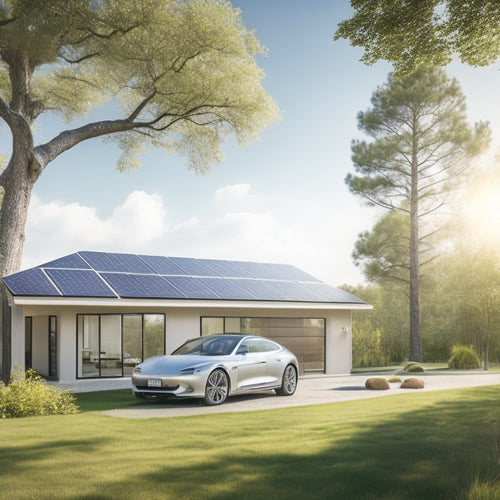
Best Home Battery Systems for Renewable Energy
Share
When it comes to choosing the best home battery system for your renewable energy setup, you've got options. Lithium-ion batteries offer a longer lifespan, higher depth of discharge, and increased efficiency, making them a popular choice for residential use. Lead-acid batteries, on the other hand, have a shorter lifespan and lower efficiency. Consider key features like energy storage capacity, system compatibility, energy density, longevity, and total usable capacity to guarantee you get the right fit. With so many factors to weigh, it's essential to evaluate your specific needs and learn more about the top systems to make an informed decision that powers your sustainable living goals.
Key Takeaways
- Lithium-ion batteries offer a longer lifespan, higher depth of discharge, and increased efficiency compared to lead-acid batteries.
- System compatibility with existing infrastructure, energy storage capacity, and energy density are crucial features to consider when selecting a home battery system.
- Renewable energy sources supported by home battery systems include solar power, wind energy, hydropower, biomass solutions, and geothermal energy.
- Installation costs range from $3,000 for DIY setups to over $30,000 for high-capacity systems, with average costs falling between $8,000 and $15,000.
- Key performance indicators for home battery systems include battery capacity, cycle life, and charge efficiency, which are critical for evaluating system performance and justifying investment.
Top Battery System Options
You're likely pondering several home battery systems, but which ones are the best? When it comes to choosing a reliable and efficient home battery system, you have several options to evaluate.
Lithium-ion batteries are a popular choice, offering several advantages over traditional lead-acid batteries. For one, lithium-ion batteries have a longer lifespan, with some lasting up to 15 years or more. They also have a higher depth of discharge, meaning you can use more of the battery's capacity without reducing its lifespan.
Additionally, lithium-ion batteries are more efficient, with higher round-trip efficiencies that reduce energy waste. In contrast, lead-acid batteries have several drawbacks, including a shorter lifespan, lower depth of discharge, and lower efficiency.
They're also heavier and larger than lithium-ion batteries, making them less ideal for residential use. When selecting a home battery system, it's crucial to weigh these factors and evaluate your specific energy needs and goals.
Key Features to Consider
When evaluating home battery systems, you'll want to contemplate the energy storage capacity that meets your specific needs, factoring in elements like your energy usage patterns and backup requirements.
You'll also need to assess the system's compatibility with your existing infrastructure, including your solar panel system, inverter, and electrical panel.
Energy Storage Capacity
Energy storage capacity is a vital aspect of home battery systems, as it directly impacts the amount of electricity you can store and use during power outages or peak hours. When evaluating home battery systems, you need to take into account the energy storage capacity to guarantee it meets your power needs. A higher energy storage capacity means you can store more electricity and use it when you need it most.
You should also take into account the energy density of the battery system, which affects the overall size and weight of the system. A higher energy density means a smaller and lighter system, making it easier to install and maintain.
Additionally, the longevity impact of the energy storage capacity is essential. A system with a longer lifespan can provide a higher return on investment and reduce waste.
When selecting a home battery system, look for the total usable capacity, depth of discharge, and cycle life. These factors will help you determine the system's energy storage capacity and its ability to meet your power needs over time.
System Compatibility Needs
System compatibility is a critical consideration when selecting a home battery system, as it directly affects the system's performance and functionality.
You'll need to guarantee that your chosen system integrates seamlessly with your existing renewable energy setup, including solar panels, wind turbines, or other energy sources. Incompatibility can lead to reduced efficiency, decreased lifespan, or even system failure.
To avoid these issues, you should conduct thorough compatibility assessments before making a purchase. Check the system's compatibility with your existing equipment, including the type and brand of solar panels, inverters, and charge controllers.
Also, consider the system's integration with your home's electrical infrastructure, including the grid connection and electrical panel.
When evaluating system compatibility, look for features like modular design, flexible communication protocols, and compatibility with multiple energy sources.
A system that can adapt to your unique energy needs will provide you with reliable, efficient, and sustainable power. By prioritizing system integration and compatibility, you'll guarantee a seamless and efficient shift to renewable energy.
Renewable Energy Sources Supported
As you investigate the world of home battery systems, you'll likely want to know which renewable energy sources they can support. The good news is that most modern home battery systems are designed to be compatible with a variety of renewable energy sources.
Solar power is a natural fit, as it's one of the most popular forms of renewable energy for homes. Many home battery systems can seamlessly integrate with solar panels, storing excess energy generated during the day for use at night or during power outages.
Wind energy is another option, with some systems capable of utilizing the power of wind turbines to charge your batteries.
Hydropower systems, which convert the energy of moving water into electricity, can also be paired with home battery systems. Biomass solutions, which involve burning organic matter to generate electricity, can also be supported.
Even geothermal energy, which taps into the Earth's heat to produce electricity, can be integrated with some home battery systems.
When choosing a home battery system, consider the type of renewable energy source you plan to use and verify the system is compatible with your needs.
Cost and Installation Factors
When contemplating a home battery system, you'll likely want to know what it'll cost you upfront and what's involved in installing it. Installation costs vary widely depending on the type and size of the system, as well as the complexity of the installation.
On average, you can expect to pay between $8,000 and $15,000 for a fully installed system. However, prices can range from as low as $3,000 for a basic DIY setup to over $30,000 for a high-capacity, professionally installed system.
In addition to the upfront cost, you'll also need to evaluate ongoing maintenance requirements. Most home battery systems require regular software updates, battery balancing, and occasional replacement of worn-out components.
While some manufacturers offer maintenance-free systems, others may require more hands-on involvement. Be sure to factor in the cost of maintenance and potential repairs when calculating the total cost of ownership.
It's also important to assess the potential savings a home battery system can provide. By storing excess energy generated by your renewable energy sources, you can reduce your reliance on the grid and lower your electricity bills.
Additionally, many governments offer incentives and tax credits for homeowners who invest in renewable energy systems, which can help offset the initial installation costs.
Battery Capacity and Performance
Into the heart of your home battery system lies the battery itself, whose capacity and performance greatly impact the overall effectiveness of the setup. You need to take into account the battery's capacity, measured in kilowatt-hours (kWh), to determine how much energy it can store and provide to your home. A higher capacity means more energy available during power outages or when the grid is down.
When evaluating battery performance, you should look at the cycle life, which refers to the number of charge and discharge cycles the battery can handle before its capacity starts to degrade. A longer cycle life means the battery will last longer and provide more reliable performance over time.
Another key factor is charge efficiency, which measures how well the battery converts incoming energy into stored energy. A higher charge efficiency means less energy is wasted as heat, and more is available to power your home.
When choosing a battery system, take into account your energy needs and the system's overall performance. Will it provide enough power during extended outages? Does it have a long enough cycle life to justify the investment?
Safety and Warranty Concerns
The safety of your home battery system is paramount, and you should scrutinize the manufacturer's safety features and certifications before making a purchase. Look for certifications like UL (Underwriters Laboratories) or ETL (Intertek), which guarantee the system meets rigorous safety standards.
You should also consider the system's battery chemistry, as some types are more prone to overheating or thermal runaway than others.
Proper battery maintenance is essential for fire prevention. Confirm the manufacturer provides clear guidelines for maintenance, including regular software updates, monitoring, and physical inspections.
Some systems may require more frequent maintenance than others, so factor this into your decision. Additionally, consider the system's built-in safety features, such as overcharge protection, short-circuit protection, and thermal monitoring.
A good warranty should also be a top priority, covering parts and labor for a reasonable amount of time. Be wary of manufacturers that offer limited or no warranty, as this may indicate a lack of confidence in their product's reliability.
Frequently Asked Questions
Can I Use a Home Battery System With a Non-Renewable Energy Source?
You're not tied to a single energy source, just like a puzzle piece fits multiple images. You can integrate a home battery system with a non-renewable energy source, leveraging battery integration for efficient energy storage and backup power when you need it most.
Are Home Battery Systems Compatible With Existing Electrical Panels?
You'll be happy to know that most home battery systems are designed for seamless integration with your existing electrical panel, ensuring home battery compatibility and efficient electrical panel integration without requiring a complete overhaul.
Do I Need Professional Installation for a Home Battery System?
You'll likely need professional installation for a home battery system, as it requires complex electrical work, but DIY options exist, albeit with higher installation costs, and you should weigh the trade-offs between convenience, safety, and upfront expenses.
Can I Expand My Home Battery System in the Future?
You can future-proof your investment by choosing a battery system that allows for future expansion and guarantees battery compatibility, so you can easily add more capacity or upgrade as your energy needs evolve.
Are Home Battery Systems Eligible for Government Incentives?
You're sitting on a goldmine of savings! Yes, you're eligible for government incentives, like tax credits, for investing in energy-efficient home battery systems, which can considerably reduce your energy bills and enhance your renewable energy setup's ROI.
Related Posts
-

Why Invest in Solar Car Battery Chargers Online?
By investing in a solar car battery charger online, you're not only reducing your reliance on fossil fuels but also o...
-

Solar Panel System Certification Costs: A 10-Point Breakdown
You're looking to understand the costs associated with solar panel system certification. Your total certification cos...
-

Planning for an Electric Vehicle-Friendly Urban Future
As you plan for an electric vehicle-friendly urban future, you'll need to integrate high-power charging stations, sma...


